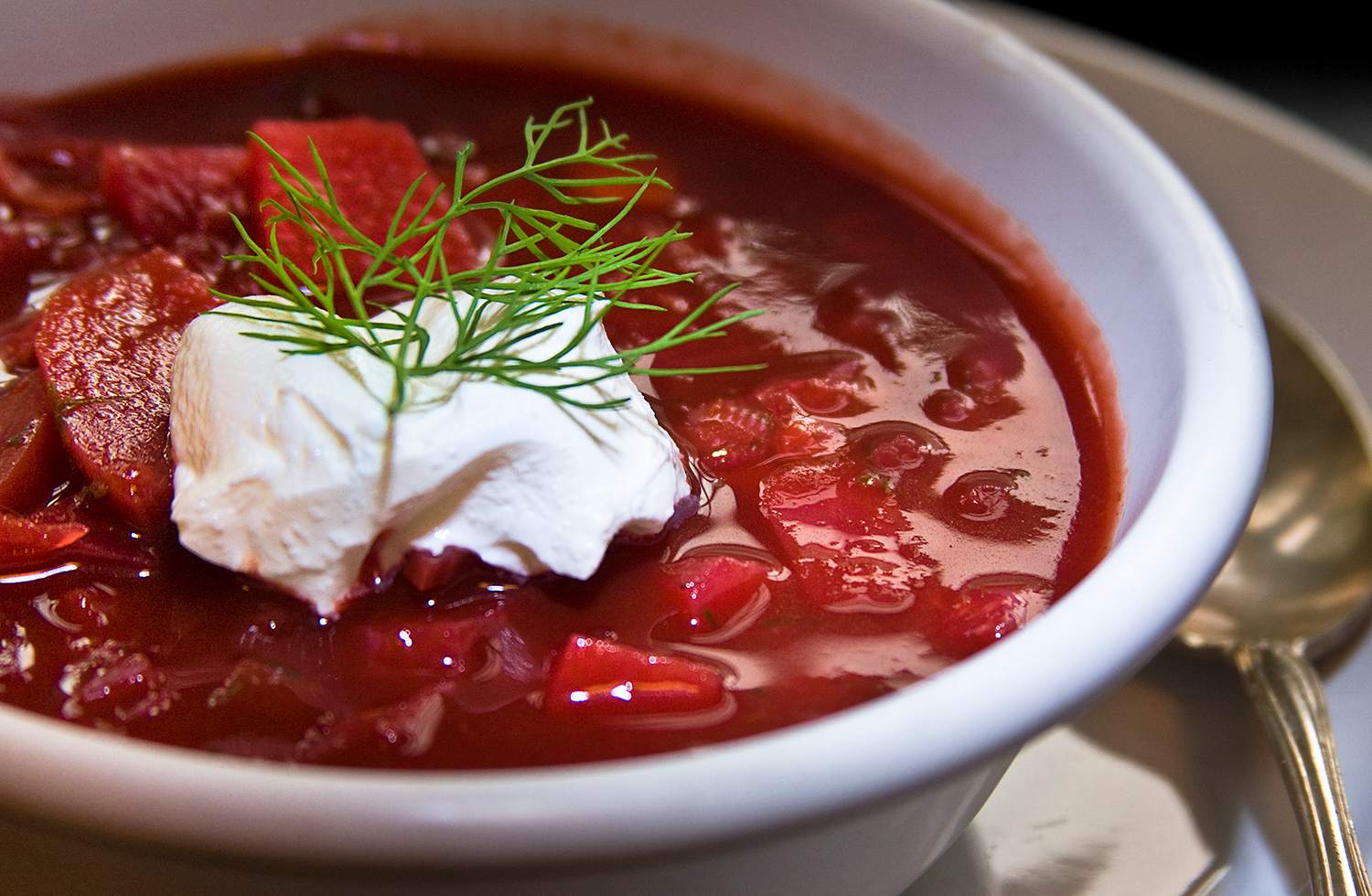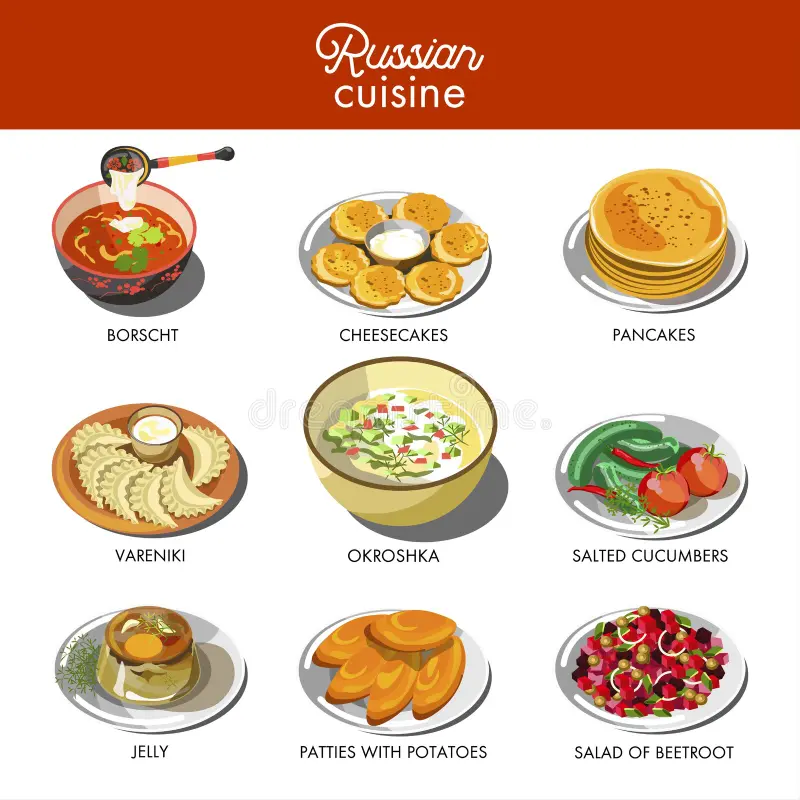Traditional Russian Cuisine Guide 2025
🍲 Traditional Russian Food – Top Dishes Defining Russia’s Culinary Soul
Russia is a vast land of rich traditions, diverse climates, and centuries-old recipes. Its cuisine reflects the resilience, creativity, and warmth of its people — hearty meals designed to bring comfort during cold winters and celebrations alike.
From the red beet soup Borscht to golden pancakes called Blini, traditional Russian food is more than just nourishment — it’s a taste of culture, history, and family. In 2025, Russian dishes are gaining global recognition for their authentic flavors, wholesome ingredients, and cultural depth.
Let’s explore the most iconic dishes that define the heart and soul of Russian cuisine.

🥣 1. Borscht – The Iconic Beetroot Soup
Perhaps no dish represents Russia more than Borscht, a bright red beet soup loved across Eastern Europe. Traditionally made with beets, cabbage, carrots, potatoes, and beef, it’s often served with a dollop of sour cream and a slice of rye bread.
Borscht’s deep flavor and vibrant color make it both comforting and visually stunning. While many Slavic countries claim their own versions, Russia’s Borscht stands out for its earthy richness and heartwarming aroma.
Fun fact: In 2025, modern chefs have begun introducing vegan Borscht versions with beetroot stock and plant-based cream — keeping the tradition alive with a modern twist.
🥟 2. Pelmeni – Russia’s Beloved Dumplings
Pelmeni are small dumplings filled with minced meat, onions, and spices — boiled or fried and served with butter or sour cream.
These dumplings originated in Siberia, where freezing temperatures helped preserve them for long journeys. Today, Pelmeni are a staple across Russian homes and restaurants.
They are the perfect comfort food — simple, filling, and deeply satisfying. You’ll often find families gathered around the table, wrapping Pelmeni together — a cherished winter tradition.
🧀 3. Syrniki – Sweet Cottage Cheese Pancakes
Syrniki are soft, fluffy pancakes made from farmer’s cheese, eggs, and flour — fried until golden and served with honey, jam, or sour cream.
Light yet rich, Syrniki are often eaten for breakfast or dessert. They combine the best of Russian simplicity and indulgence, offering a balance between creamy sweetness and crispy texture.
Syrniki have recently become popular in European cafés, where they’re celebrated as a healthy, protein-rich breakfast option.
🍞 4. Blini – Russia’s Traditional Pancakes
Blini are thin, crepe-like pancakes that date back centuries. Originally made for the Maslenitsa festival — Russia’s “Butter Week” — they symbolize the sun and the arrival of spring.
Blini can be served in countless ways: sweet with jam, honey, or berries, or savory with sour cream, salmon, or caviar.
Even in 2025, Blini remains a national favorite, uniting Russians across regions and generations.
🍲 5. Shchi – The Classic Cabbage Soup
Shchi is a traditional cabbage soup, one of the oldest dishes in Russian cuisine. Made with fresh or fermented cabbage, carrots, potatoes, and herbs, it’s a flavorful and nutritious meal that warms the body during cold weather.
For centuries, Shchi has been the everyday meal of peasants and nobles alike — a symbol of Russian endurance and simplicity.
Modern restaurants now serve variations of Shchi using chicken, mushrooms, or sour cream for added richness.
🍗 6. Beef Stroganoff – Russia’s International Star
One of Russia’s most famous exports, Beef Stroganoff combines tender beef strips, onions, mushrooms, and sour cream into a creamy, savory sauce served over noodles or rice.
Named after the noble Stroganov family, this dish reflects 19th-century Russian elegance. Today, it’s found in kitchens around the world, adapted to local tastes but always maintaining its signature flavor.
In 2025, chefs are reinventing Stroganoff with vegetarian alternatives using mushrooms or tofu — keeping the soul of the dish alive for modern eaters.
🥔 7. Olivier Salad – The Russian New Year Favorite
Also known internationally as “Russian Salad,” the Olivier Salad is a festive staple, especially during New Year celebrations.
It typically includes boiled potatoes, peas, eggs, carrots, pickles, and diced chicken, all mixed with creamy mayonnaise. While simple, its flavor combination creates a nostalgic charm that every Russian associates with holidays and family gatherings.
It’s one of those dishes that truly unites people — no New Year’s table is complete without it!
🧈 8. Pirozhki – Little Baked or Fried Pies
Pirozhki are small stuffed buns made from yeast dough and filled with various ingredients — from minced meat to potatoes, cabbage, or sweet jam.
They can be baked or fried and are sold everywhere — from school cafeterias to train stations and modern bakeries.
In essence, Pirozhki are the ultimate Russian street food — quick, portable, and packed with flavor. Their golden crust and soft, fluffy texture make them impossible to resist.
🍎 9. Kulebyaka – The Grand Pie of Russia
If Pirozhki are the everyday treat, Kulebyaka is the festive masterpiece. This large, layered pastry pie is filled with fish (usually salmon), rice, mushrooms, eggs, and dill — all wrapped in buttery dough.
Kulebyaka was once served to Russian tsars and remains a symbol of celebration. It’s a dish that combines artistry and taste, reflecting the depth of Russian culinary tradition.
🍯 10. Medovik – The Classic Russian Honey Cake
To end a Russian meal, there’s nothing better than Medovik, a multi-layered honey cake with cream filling. Each layer is baked with honey and stacked with sweet, creamy frosting, resulting in a dessert that’s both delicate and rich.
Medovik is a national treasure — a dessert loved across generations, served during weddings, birthdays, and family gatherings.
In 2025, pastry chefs are experimenting with new versions, adding chocolate, berries, or nuts, yet the traditional honey flavor remains unmatched.
☕ Russian Beverages – From Tea to Kvass
Food is never complete without drink, and in Russia, beverages hold a special place in daily life.
🍵 Russian Tea
Served in a glass with lemon and sugar, Russian tea is a symbol of hospitality. The samovar (a traditional tea kettle) remains a cultural icon representing warmth and togetherness.
🍞 Kvass
A fermented drink made from rye bread, Kvass is mildly fizzy and slightly sweet, with a unique taste unlike any other. It’s often considered Russia’s original soft drink — refreshing and full of probiotics.
🌍 Russian Food in 2025 – Tradition Meets Modernity
In 2025, Russian cuisine is undergoing a quiet revolution. Chefs are combining old traditions with modern ingredients, sustainability, and presentation.
-
Organic produce and farm-to-table dining are becoming popular in Moscow and St. Petersburg.
-
Vegan adaptations of classic dishes like Borscht and Pelmeni cater to global audiences.
-
Fusion food — such as Russian-Japanese or Russian-Mediterranean dishes — is bringing new life to centuries-old recipes.
Despite modernization, Russian food remains rooted in comfort, flavor, and family values that never go out of style.
💬 Why the World Loves Russian Food
Here’s why traditional Russian food continues to win hearts globally:
✅ Hearty and Comforting: Perfect for cold climates and cozy dining.
✅ Rich in History: Every dish tells a story of resilience and culture.
✅ Simple Ingredients, Deep Flavors: Potatoes, beets, flour, and butter transformed into culinary art.
✅ Cultural Experience: Shared over tea, conversation, and warmth.
✅ Adaptable: Easy to modernize while keeping authenticity intact.
🥄 Final Thoughts
Traditional Russian food is more than just a meal — it’s a reflection of the Russian spirit: strong, warm, and full of soul. Each dish, from Borscht to Medovik, carries stories of family gatherings, celebrations, and centuries of tradition.
As the world explores authentic cuisines in 2025, Russian food stands proudly among the great culinary heritages — rich in flavor, history, and heart.
So whether you’re savoring hot Pelmeni, sweet Syrniki, or sipping a cup of Russian tea, remember — you’re tasting a piece of Russia’s timeless soul. 🇷🇺❤️


